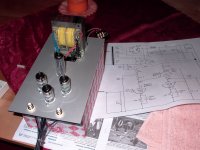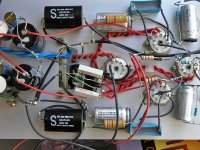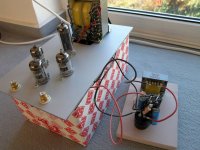I tried to search, but over 200 results came up, many of them being large threads, so please forgive me for not reading thru all of them...
I am about to finish my second amp (Morgan-Jones headphone amplifier with 3x 6922) after successfully building and de-humming my first one (c3g-headphone amp, see thread somewhere here).
I changed the psu slightly by adding a hybrid tube rectifier with two UF4006 to form the centertap (trans hasn't got one...) and a EZ81.
Now the amp is up and running for testing, voltages are in the ballpark, but upon warming up there is a strange noise coming from the rectifier....hard to describe...it's a tiny somehow mechanical noise but clearly audible (with no headphones over my ears!).
Also I' ve got some 120 Hz hum with headphones on...
Any suggestions?
Thanks in advance,
Oliver
I am about to finish my second amp (Morgan-Jones headphone amplifier with 3x 6922) after successfully building and de-humming my first one (c3g-headphone amp, see thread somewhere here).
I changed the psu slightly by adding a hybrid tube rectifier with two UF4006 to form the centertap (trans hasn't got one...) and a EZ81.
Now the amp is up and running for testing, voltages are in the ballpark, but upon warming up there is a strange noise coming from the rectifier....hard to describe...it's a tiny somehow mechanical noise but clearly audible (with no headphones over my ears!).
Also I' ve got some 120 Hz hum with headphones on...
Any suggestions?
Thanks in advance,
Oliver
Attachments
I have experienced this too while the tubes warm up -- if it is the same thing, it sounds like current and or heat rushing trough the tube causing banging and clanging and a sort of rushing noise. It has happened to me with 2 different EZ81's, but it goes away after things are warm. I just ignore it and it eventually (~30 seconds) goes away.
Hi Stixx,
I assume you are in Germany so that would be 100Hz buzz.
 Also PLEASE cover the terminals on your power transformer. I used similar ones whilst living in Belgium (teenage years long ago) and zapped myself more than once. (And they were usually covered - don't use electrical tape for this except as a temporary thing.) Accidents happen easily!
Also PLEASE cover the terminals on your power transformer. I used similar ones whilst living in Belgium (teenage years long ago) and zapped myself more than once. (And they were usually covered - don't use electrical tape for this except as a temporary thing.) Accidents happen easily! 
Clanking and banging of the envelope is not unusual with the EZ81, as doug indicates it should go away once the tube has warmed up.
Safety OT story:
Doing a repair on a Studer Revox G36 as a kid (17 or so) in the 1970's I somehow got a couple of fingers across the power switch. 220V will definitely cause a strong involuntary contraction if the connection is good enough. (It was) I watched my right arm fly into my face with fascinated horror as the muscles contracted. At the same exact moment the sound effects from "the six million dollar man" (tv show) filled my head as my arm moved in what seemed like slow motion... It was all over in less than a second, amazing how long that second was - and it really, really hurt. Left a bruise on my forehead, and burn marks on a couple of my fingers. I was very lucky. My younger brother who witnessed the whole thing thought it was hysterically funny, particularly after I mentioned the accompanying sound effects..
Edit: additional thoughts
I assume you are in Germany so that would be 100Hz buzz.
 Also PLEASE cover the terminals on your power transformer. I used similar ones whilst living in Belgium (teenage years long ago) and zapped myself more than once. (And they were usually covered - don't use electrical tape for this except as a temporary thing.) Accidents happen easily!
Also PLEASE cover the terminals on your power transformer. I used similar ones whilst living in Belgium (teenage years long ago) and zapped myself more than once. (And they were usually covered - don't use electrical tape for this except as a temporary thing.) Accidents happen easily! 
Clanking and banging of the envelope is not unusual with the EZ81, as doug indicates it should go away once the tube has warmed up.
Safety OT story:
Doing a repair on a Studer Revox G36 as a kid (17 or so) in the 1970's I somehow got a couple of fingers across the power switch. 220V will definitely cause a strong involuntary contraction if the connection is good enough. (It was) I watched my right arm fly into my face with fascinated horror as the muscles contracted. At the same exact moment the sound effects from "the six million dollar man" (tv show) filled my head as my arm moved in what seemed like slow motion... It was all over in less than a second, amazing how long that second was - and it really, really hurt. Left a bruise on my forehead, and burn marks on a couple of my fingers. I was very lucky. My younger brother who witnessed the whole thing thought it was hysterically funny, particularly after I mentioned the accompanying sound effects..
Edit: additional thoughts
kevinkr said:My younger brother who witnessed the whole thing thought it was hysterically funny
As it turned out well, he was right. Thin line between tragedy and comedy.
Sheldon
As it turned out well, he was right.
Or "The essence of comedy is other peoples misfortune"
-Casey
Hi folks,
thank you for the overwhelming reply...
in fact it seems that the rectifier noise is only temporary...today i switched it back on and no noise at all...at least from the rectifier.
So thanks Sheldon, dsavitsk and ivegotmono...
The 100Hz hum is still quite prominent though...
My grounding is via a bussbar that runs from the right rca (outside of picture) to one of the transformer bolts where also my safety ground is connected (green-yellow wire in Germany). All the grounds around the input tube form a sub-star that is connected to the buss...
My psu at the moment (no chassis yet) is mounted on a small board and connected with short leads...the virtual centertap of the transformer going to the second cap (100uF). psu is CLCRC with a small 1uF mkp as first cap. Currently there is no volume control, but it shouldn't hum that much anyway...
any ideas?
Thank you,
Oliver
PS @kevinkr: of course i will have a cover for the trans once the chassis is finished...
thank you for the overwhelming reply...
in fact it seems that the rectifier noise is only temporary...today i switched it back on and no noise at all...at least from the rectifier.
So thanks Sheldon, dsavitsk and ivegotmono...
The 100Hz hum is still quite prominent though...
My grounding is via a bussbar that runs from the right rca (outside of picture) to one of the transformer bolts where also my safety ground is connected (green-yellow wire in Germany). All the grounds around the input tube form a sub-star that is connected to the buss...
My psu at the moment (no chassis yet) is mounted on a small board and connected with short leads...the virtual centertap of the transformer going to the second cap (100uF). psu is CLCRC with a small 1uF mkp as first cap. Currently there is no volume control, but it shouldn't hum that much anyway...
any ideas?
Thank you,
Oliver
PS @kevinkr: of course i will have a cover for the trans once the chassis is finished...
Attachments
Looking at the wiring pic, it's probable that the 6922 (alias ECC88) is quietly oscillating. As with all highish mu RF tubes, pay attention to short leads and decoupling right on the tube sockets. It could be oscillating and the hum modulating it creating deception..... A screening can may do the trick.
The EZ81 hasn't got a third electrode so it can't oscillate. It can resonate in a circuit with either L or C or both.
richj
The EZ81 hasn't got a third electrode so it can't oscillate. It can resonate in a circuit with either L or C or both.
richj
I'd make a couple of additional changes:
Make your grounds a real star. Just run the individual connections back to your main star. You might consider lifting the input ground with a 20-100 ohm resistor.
Move your virtual ground resistors to your power supply and run a single wire back to the star to get it away from your tubes and make a little more room.
Daisy chain your heater wires from one tube to the next, or run a single twisted pair to the input tube and branch the other two from that. Will reduce the amount of heater wiring a little.
Sheldon
Make your grounds a real star. Just run the individual connections back to your main star. You might consider lifting the input ground with a 20-100 ohm resistor.
Move your virtual ground resistors to your power supply and run a single wire back to the star to get it away from your tubes and make a little more room.
Daisy chain your heater wires from one tube to the next, or run a single twisted pair to the input tube and branch the other two from that. Will reduce the amount of heater wiring a little.
Sheldon
Your "virtual center tap" should connect directly to the first cap in the supply even though it is a small value, and from there to the second cap - then this point should go to the star ground. (Lots of 100Hz ripple current in those caps.)
The filaments should not be floating, they need a good ac ground, and in this case elevating them above ground with a resistive divider to the B+ is a good idea. Bypass the divider to ground with a small electrolytic of suitable voltage rating - usually 10uF will be enough.
Make sure both RCA jacks are grounded to exactly the same point on your ground buss, and most properly this should also form the point where your star ground exists or at least the connection to the chassis.
6922 make good vhf oscillators, a small resistor in series with the grid connections should decouple it from the inductance and stray capacitance in the wiring. 220 (221) ohm resistor right at the pin should be just fine.
The filaments should not be floating, they need a good ac ground, and in this case elevating them above ground with a resistive divider to the B+ is a good idea. Bypass the divider to ground with a small electrolytic of suitable voltage rating - usually 10uF will be enough.
Make sure both RCA jacks are grounded to exactly the same point on your ground buss, and most properly this should also form the point where your star ground exists or at least the connection to the chassis.
6922 make good vhf oscillators, a small resistor in series with the grid connections should decouple it from the inductance and stray capacitance in the wiring. 220 (221) ohm resistor right at the pin should be just fine.
I think I've got plenty to do over Xmas...

Thanks again for your help and happy holidays to you all...don't feast too much on that turkey (or what is it again for chrismas in the US...not to forget switzerland...!
The input 6922 has gridstoppers of 100R, so I might as well add some to the other two ...pay attention to short leads and decoupling right on the tube sockets.
I will try that...Move your virtual ground resistors to your power supply and run a single wire back to the star to get it away from your tubes and make a little more room.
Same again...why didn't that occur to me...Daisy chain your heater wires from one tube to the next, or run a single twisted pair to the input tube and branch the other two from that. Will reduce the amount of heater wiring a little.

They are not floating, they are tied to ground via two 100R resistors (visible between the ww resistors...) The voltage divider is a good idea since it is suggested by MJ as well...not in the original schematic on headwize though.The filaments should not be floating, they need a good ac ground, and in this case elevating them above ground with a resistive divider to the B+ is a good idea. Bypass the divider to ground with a small electrolytic of suitable voltage rating - usually 10uF will be enough.
Thanks again for your help and happy holidays to you all...don't feast too much on that turkey (or what is it again for chrismas in the US...not to forget switzerland...!
Stixx said:The voltage divider is a good idea since it is suggested by MJ as well...not in the original schematic on headwize though.
Thanks again for your help and happy holidays to you all...don't feast too much on that turkey (or what is it again for chrismas in the US...not to forget switzerland...!
Highly recommended on lifting the heaters. Can reduce filament induced hum by good amount.
Christmas dinner here varies. Some repeat the Thanksgiving dinner, some have a Ham, or roast beef, or maybe leg of lamb. And of course different ethnic groups sometimes go with their own traditions.
Sheldon
If you are using the 6922 in cathode follower, (which is quite common) then tight layout is crutial with 10K grid stoppers. I was a bit short of detail on in earlier thread, that I found it necessary to fit decoupling caps directly on tube socket (anode) with shortest connection to chassis.
If I'm correct, this tube has a limited cathode/heater max of 100V difference. YOu might not be using cath follower, but even so as others mentioned the heater supply should be decoupled to see a "virtual earth" impedance to eliminate any noise.
I was fortunate at the time I was using an ECC88 in a preamp and unsuspecting anything was wrong that I also had a TV on with poor signal......later found out the "snow storm" was created by the ECC88.....such luck!
Despite the popularity of the 6922 group, perhaps the lower mu 6N1P might be better less troublesome for such applications. It's still rel cheap.
richj
If I'm correct, this tube has a limited cathode/heater max of 100V difference. YOu might not be using cath follower, but even so as others mentioned the heater supply should be decoupled to see a "virtual earth" impedance to eliminate any noise.
I was fortunate at the time I was using an ECC88 in a preamp and unsuspecting anything was wrong that I also had a TV on with poor signal......later found out the "snow storm" was created by the ECC88.....such luck!
Despite the popularity of the 6922 group, perhaps the lower mu 6N1P might be better less troublesome for such applications. It's still rel cheap.
richj
I have an ez81 in my 5 watt SE guitar amp. When I first wired it up, I thought it would be a good idea to put the standby switch inline with the output of the tube. Turns out, this made the plates buzz like crazy, so I changed the switch to the center tap on the transformer and the buzz went away.
My ez81 makes some noise when turning on, but it only sounds like normal metal/glass heating up and expanding/contracting , similar to an electric stove element.
My ez81 makes some noise when turning on, but it only sounds like normal metal/glass heating up and expanding/contracting , similar to an electric stove element.
- Status
- This old topic is closed. If you want to reopen this topic, contact a moderator using the "Report Post" button.
- Home
- Amplifiers
- Tubes / Valves
- EZ81 rectifier noise


